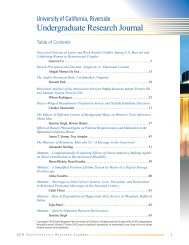UC Riverside Undergraduate Research Journal
UC Riverside Undergraduate Research Journal
UC Riverside Undergraduate Research Journal
Create successful ePaper yourself
Turn your PDF publications into a flip-book with our unique Google optimized e-Paper software.
Zero Waste Biodiesel: Using Glycerin And Biomass To Create Renewable Energy<br />
Sean Brady<br />
Introduction<br />
Biodiesel is a popular alternative fuel. It is carbon<br />
neutral, has emissions equivalent to or below diesel, is<br />
biodegradable, non-toxic, and is significantly cheaper<br />
to manufacture than its petroleum equivalent. However<br />
there is one significant drawback: for every 10 gallons of<br />
biodiesel produced, roughly 1 gallon of glycerin is created<br />
as a byproduct.<br />
Although glycerin does have its industrial uses,<br />
current biodiesel production has already exceeded market<br />
demand, leaving large amounts of practically worthless<br />
glycerin in the manufacturers’ hands, leading to increased<br />
disposal costs. We show that by combining waste glycerin<br />
with waste biomass (corn husks, wheat chafe, etc.), we are<br />
able to produce pellets which can be easily and inexpensively<br />
manufactured, are suitable for existing combustion energy<br />
plants, and are a superior alternative to coal.<br />
Glycerin Pellets<br />
The idea of combining the waste glycerin from the<br />
biodiesel process with biomass is relatively new and no<br />
other projects using this idea have been published. The<br />
concept originated on a Biodiesel Internet forum where<br />
home brewers were brainstorming ways to utilize their<br />
excess glycerin. Many users discussed creating soap,<br />
lotions, and using the glycerin in food products, but many of<br />
these processes require purification, a chemically unstable<br />
process, and are inherently low-volume and low-demand.<br />
Other uses for glycerin include selling it to a company which<br />
Figure 1. Sample pellets containing biomass (sawdust) and<br />
glycerin in a ratio of 1 to 1.3.<br />
refines glycerin for use in food or pharmaceuticals. While<br />
once profitable, the current abundance of glycerin is such<br />
that there is little money to be made, and often money to be<br />
paid, in having a company pick up your glycerin. However<br />
one user caught our attention with the words “glycerin logs,”<br />
to be burned in traditional fireplaces. Although glycerin<br />
logs were ultimately unfeasible, it started us thinking about<br />
ways to create solid form, easily portable fuel sources for<br />
combustion energy. We ultimately found a way to absorb<br />
two waste streams, thereby enabling biodiesel production, by<br />
creating a product which could reduce the coal dependence<br />
in the world.<br />
Biodiesel<br />
Biodiesel has been well explored by industry and<br />
in academia for at least 30 years. As biodiesel is broadlydefined<br />
as any chemical that is a methyl ester, an acceptably<br />
vague definition because of the wide range of chemicals<br />
which can be combusted in a diesel engine. Due to this<br />
flexibility of definition and use, many different methods can<br />
be employed, even some that do not create waste glycerin.<br />
These processes, however, have their drawbacks.<br />
These often do not create a significant quantity of<br />
byproduct, and are usually terribly energy intensive. Often<br />
times the thinning procedure also leads to a weaker or<br />
undesirably volatile fuel. The major methods for creating<br />
a less viscous fuel from vegetable oil are dilution, microemulsification,<br />
pyrolysis, and trans-esterification 1 . Pyrolysis<br />
is fairly energy intensive, and leads to a loss of feed.<br />
Dilution and micro-emulsification processes will lead to<br />
lower quality fuel, and<br />
have large initial material<br />
costs. Trans-esterification,<br />
or the thinning process<br />
that chemically lowers<br />
the viscosity of the<br />
mixture, sticks out as an<br />
economically reasonable<br />
Figure 2. Biodiesel glycerin<br />
mixture<br />
process, especially if a<br />
market can be established<br />
for the post process glycerin.<br />
Lately, biologically-based<br />
reactions, such as lipasecatalyzed<br />
processes for<br />
creating biodiesel, have<br />
6 <strong>UC</strong>R Un d e r g r a d u a t e Re s e a r c h Jo u r n a l














